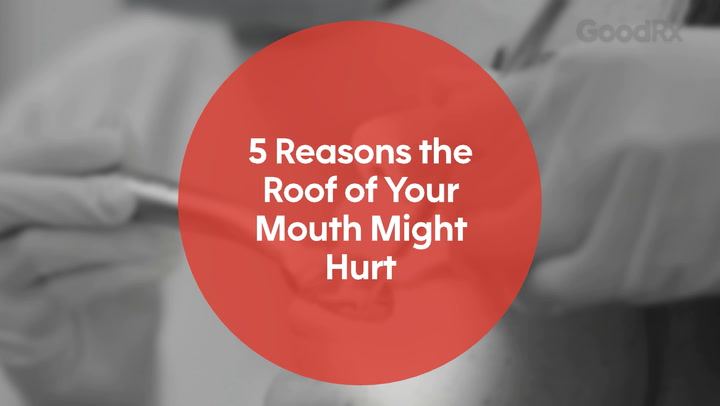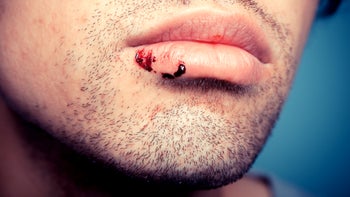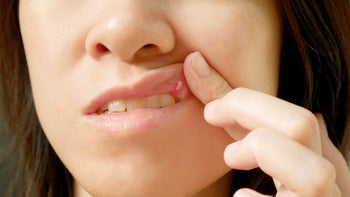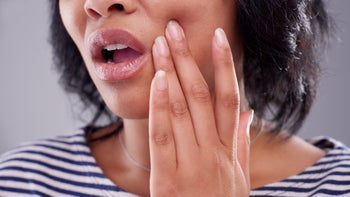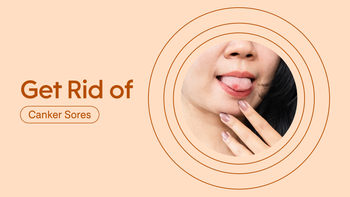
7 Ways to Get Rid of Canker Sores Fast (With Pictures)
Key takeaways:
Canker sores are one of the most common conditions affecting the mouth. They’re usually mild and resolve on their own in 1 to 2 weeks.
There are over-the-counter (OTC) and prescription medications that can make canker sores feel better. Some treatments can even help canker sores go away faster.
Canker sores aren’t usually serious, but they can sometimes be a sign of an underlying medical condition. If you have recurring canker sores, it’s important to talk to a healthcare professional.
Table of contents
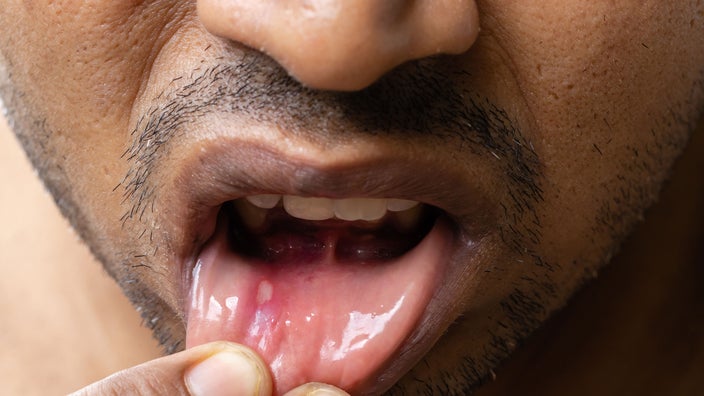
Almost everyone has had a tiny sore in their mouth that made it painful to eat or talk. That annoying little ulcer was most likely a canker sore. Canker sores are one of the most common mouth conditions in the U.S. Almost everyone will have a canker sore at least once. And about 1 in 5 people will have them repeatedly over their lifetime.
Because canker sores are quite painful, many people look for quick at-home remedies to treat them. Let’s take a closer look at what canker sores are and what you can do to get rid of them quickly.
What are canker sores?
Canker sores (aphthous ulcers) are painful, white- or yellow-topped ulcers within the mouth. They can happen inside the cheeks, on the gums, or on the tongue. Most people only get one canker sore at a time. But some people get several at a time.
Canker sores are defined by their size, number, and appearance. Canker sores can be:
Minor: These canker sores are small. They’re usually just a few millimeters in size.
Major: These canker sores are larger, about 1 cm to 3 cm in diameter.
Herpetiform: These canker sores are made of many pinhead-sized ulcers bunched together.
What causes canker sores?
Even though canker sores are very common, healthcare professionals don’t really know what causes them. Some people get them frequently. Others never do.
What causes canker sores? From stress to underlying medical conditions, learn the most common causes of canker sores.
What’s it like to have canker sores? Three people share their experience on what it’s like to have — and treat — these common sores.
Canker sores vs. cold sores: Learn how to tell the difference between these two common conditions (with pictures).
Some of the triggers for canker sores include:
Injury
Stress
Vitamin deficiency (like B12, folic acid, or iron)
Smoking
Hormonal changes
Viral infections
How to get rid of canker sores fast
Canker sores usually go away on their own in a few days. But there are over-the-counter (OTC) treatments that may speed up healing or lessen the pain.
Here are seven ways you may be able to speed the healing of your canker sore.
1. Mild or salt water mouthrinse
Mild mouthrinses like salt water may help to heal your canker sore. Mouthrinses can decrease bacteria and inflammation in the mouth. If possible, rinse your mouth several times a day using salt water or a mild mouthwash. But you’ll want to be careful what you use. You’ll need to avoid using a mouthwash that contains alcohol. This can be irritating.
2. Hydrogen peroxide
Hydrogen peroxide can help to improve healing of your canker sore by keeping it clean. Hydrogen peroxide works as an antiseptic to decrease the amount of bacteria in and around the ulcer. You can apply a 50-50 mixture of hydrogen peroxide and water directly to the sore using a clean cotton swab.
3. Milk of magnesia
Milk of magnesia is commonly used for constipation. But it can also help with canker sore pain and reduce its healing time. It’s best used after first cleansing the canker sore with hydrogen peroxide. You can then follow with a dab of milk of magnesia applied directly on the canker sore.
4. Magic mouthwash
Magic mouthwash can help with the pain of a canker sore and can make it go away faster. But you’ll need a prescription for this one.
This is usually a combination of antacid, antihistamine, and a local anesthetic. You don’t swallow the mixture. Rather, you typically gargle with it. Just swish it around in your mouth for about 1 minute, then spit it out.
5. Topical pain reliever
You can try an OTC pain reliever like benzocaine, which is typically found in products like Orajel or Anbesol. These work as a topical anesthetic. They don’t work to heal the canker sore. However, these gels can help you get through the tough first days when the inflammation and pain is high.
6. Cold, bland foods
Cold, bland foods may be easier to tolerate and less irritating when trying to get a canker sore to heal. As it turns out, spicy, salty, or abrasive foods can increase inflammation and prolong the healing time.
7. Honey
Honey applied to a canker sore may speed up healing. Honey is known for its antibacterial and anti-inflammatory properties. So, it can work well as an at-home remedy to get rid of canker sores fast. Applying honey to your canker sore 4 times a day for 5 days can work to decrease pain, redness, and its size.
How long do canker sores typically last?
Canker sores will usually resolve on their own over time. They’ll typically run their course in about 2 weeks. Canker sores will typically follow a predictable pattern, like:
Prodromal stage: This stage lasts 1 to 3 days. You might notice a tingling or burning sensation at the spot where the ulcer will erupt.
Ulcer stage: This stage can last 3 to 6 days or longer. The ulcer is often very painful and sensitive at this stage.
Healing stage: This stage can last a few days for minor ulcers. It can last a couple of weeks for major ulcers. Sometimes, major ulcers can leave scars as they heal.
If a canker sore doesn’t heal within 2 to 3 weeks, or if there are many sores, talk to a healthcare professional to find out if something more serious is going on.
What does a canker sore look like?
People can sometimes mistake canker sores for other things, like fever blisters. But canker sores look different from cold sores (fever blisters). Fever blisters are very contagious and usually occur on or around the lips. Luckily, canker sores aren’t contagious. Also, they appear inside the mouth.
Canker sores usually appear anywhere inside the mouth as round, white, or yellow sores with a red border. You can have one or multiple at the same time. Below are some pictures of canker sores in different locations.




Other signs of a canker sore include:
A burning or tingling sensation at the site before the sore appears
Swelling in the area around the sore
Pain as the main symptom of a canker sore
There’s usually no fever with canker sores. If you do get a fever with your canker sore, there may be another condition causing your symptoms.
How can you prevent canker sores?
There’s no sure way to prevent canker sores. But avoiding known triggers may keep you from having future episodes. If you have them repeatedly, you may also consider getting your vitamin levels checked. And you may want to have testing done for a food allergy.
Some people find it helpful to eliminate certain things from their diet, like spicy foods or gluten. Good oral hygiene is also important. Brushing with a soft bristle toothbrush and flossing regularly can minimize irritation that could lead to canker sores.
When should I see a doctor or dentist about canker sores?
Canker sores usually don’t have any other symptoms than pain and ulcers. Warning signs that should prompt you to see a healthcare professional include:
Fever
Blisters on the skin
Eye redness
Any kind of sore if you have a weakened immune system
Trouble eating or drinking
Feeling generally ill
Sores lasting more than 10 days without improving
That’s because not all ulcers in the mouth are simple canker sores. Rarely, ulcers in the mouth can be a sign of an infection or autoimmune or gastrointestinal disease.
Medical conditions that can appear with mouth sores are:
Syphilis or gonorrhea
Inflammatory bowel disease or celiac disease
Oral cancer
Oral candidiasis (thrush)
Frequently asked questions
No. Canker sores aren’t caused by herpes, so they aren’t contagious. Cold sores (also called fever blisters) are caused by the herpes virus. They can be spread through direct contact (like kissing). Or they can spread by touching a contaminated object (like a glass).
Having a canker sore on the tongue can be pretty painful. But the treatment is similar to canker sores in other locations. Start by using a topical pain reliever (like benzocaine) to help minimize symptoms. Then use a combination of different treatments to help it heal quickly, including:
Cleaning it with hydrogen peroxide
Gargling with magic mouthwash
Applying milk of magnesia or honey
No, you can’t pop a canker sore. Canker sores are open sores called ulcers. They aren’t filled with fluid or pus, and they can’t be popped. Squeezing or trying to pop a canker sore can cause more pain and irritation, and it can lead to an infection.
The bottom line
Canker sores are so common that you’ll likely have at least one in your lifetime. They usually run their course within 2 weeks and go away on their own. But if they’re very painful or interfering with eating, there are treatment options that can help them go away faster. If you have canker sores that don’t seem to be improving, make sure you have a healthcare professional take a look.
Why trust our experts?



Images used with permission from VisualDx (www.visualdx.com).
References
Chiarito, S. A. (2023). Canker sores. Familydoctor.org.
Colgate. (n.d.). Can you use hydrogen peroxide on a canker sore?
Colgate. (2023). How salt water mouth rinse benefits oral health.
Hennessy, B. J. (2024). Mouth sores and inflammation. Merck Manual Consumer Version.
InformedHealth.org. (2022). Canker sores (mouth ulcers): Learn more – what can you do if you have a canker sore? National Library of Medicine.
InformedHealth.org. (2022). Overview: Canker sores (mouth ulcers). National Library of Medicine.
Jajam, M., et al. (2017). Oral manifestations of gastrointestinal disorders. Journal of Clinical and Experimental Dentistry.
Malahias, T. (n.d.). Oral health. Celiac Disease Foundation.
MedlinePlus. (2023). Canker sore.
MouthHealthy. (n.d.). Canker sores. American Dental Association.
National Institute of Dental and Craniofacial Research. (2024). Fever blisters & canker sores. National Institutes of Health.
Plewa, M. C., et al. (2023). Recurrent aphthous stomatitis. StatPearls.


